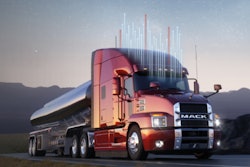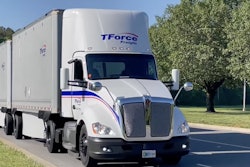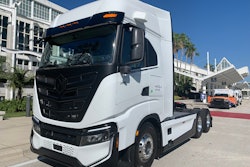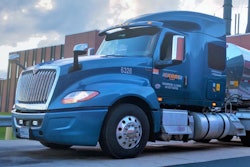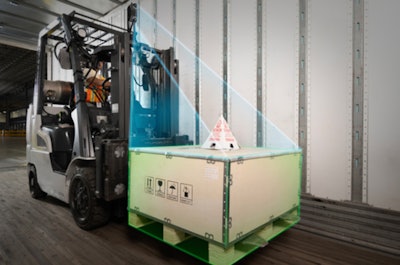
Logistics company ArcBest in 2023 rolled out an innovative suite of hardware, including a customizable mobile platform that allows freight to be loaded and unloaded outside of the trailer and a coupler device on a forklift that enables the mobile platform to move in and out of the trailer and around the warehouse.
It landed the company on CCJ’s list of 2023 Innovators.
Last year, the company added to its Vaux Freight Movement System with Vaux Smart Autonomy, which combines autonomous mobile robot forklifts and reach trucks with fleet management software and teleoperation capabilities to automate material handling while keeping a human operator involved.
Now, it has added yet another element to the forklift to make warehouse and dock operations easier and more efficient.
The company recently launched the pilot of its new Vaux Vision technology, which transforms forklifts into intelligent mobile dimensioners using 3D perception technology.
In addition to providing dimensions, sensors that look like cameras are mounted above and below the mast of the forklift, capturing images upon approach and departure that are then sent to the cloud where generative AI models can determine specific attributes of the freight like damage, HazMat, stackable, fragile and leaning. The technology, which can handle freight of various shapes and sizes, also tracks the piece ID or pallet barcode.
Dennis Anderson, chief innovation officer at ArcBest, said this newest addition to the company’s tech suite was born out of necessity.
“One of the ways that we innovate at ArcBest is … we start with what's the problem to solve, and we work from there. That’s where we started with the freight movement system, first thinking about more broadly how to move things in and out of trailers, particularly, and then how to more efficiently operate within a facility,” Anderson said.
He said after launching the Vaux Freight Movement System, which allows swarm processing from all sides of the mobile platform, ArcBest realized there’s not enough labor in warehouses to move things as effectively and efficiently as desired. That led to Vaux Smart Autonomy, which ultimately led to the creation of Vaux Vision.
“One of the things that we've noticed that we’re solving for in the smart autonomy world is the ability to see things from the forklift, to read barcodes. We needed that really for the freight movement system but also for smart autonomy,” Anderson said. “That vision perception idea led to what's been a pain point for a while, particularly in the less than truckload industry, of carriers and shippers needing to have a more efficient and effective way to capture dimensions of freight.”
In the LTL industry, carriers are always looking to maximize the amount of freight they have for the amount of space it takes up – constantly playing the game between space and weight, he said. That has attributed to the popularity of static dimensioners located in a particular area of the facility, where a forklift either drives through or drops a pallet onto it.
But, Anderson said, those are expensive to install, and they completely rearrange workflow, creating inefficiency.
“What often happens is it actually reduces the effective amount of freight that's able to be dimensioned,” Anderson said. “… Bringing that down to the forklift level helps with that operational workflow. It helps with the upfront expense outlay, and then it also reduces the setup times. It's pretty easy to implement. We're seeing setup times anywhere from eight hours to two days, so it's a lot more accessible.”
He said the forklift dimensioner is not unlike what happened with weighing. Scales have long been built into forklifts, putting the activity of verifying weight of the shipment directly into the workflow. And when you can trim down the dimensioner into a package that fits on a forklift, he said it’s generally going to be less expensive than buying one large piece of capital equipment.
It also creates revenue opportunities, Anderson said.
For carriers, it allows them to dimension more freight than would be achievable with static dimensioners, and it helps ensure more accurate freight charges and better trailer utilization.
For shippers, it allows them to be better at shipment planning strategies and can also lead to cost savings from things like reduced accessorial charges, exceptions and rebuilds and ultimately allows more throughput through their supply chain. Anderson said it could also benefit shippers in other use cases like better understanding how to build racking in their warehouses, for example.
“We've just scratched the surface on what these images would be able to be used for and what our generative AI models can do. I see that maybe even getting more useful over time,” he said.




